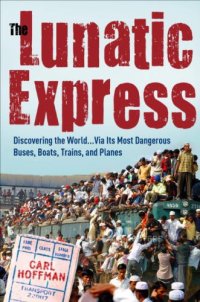
Ebook: The lunatic express: discovering the world ... via its most dangerous buses, boats, trains, and planes
Author: Hoffman Carl
- Tags: Transportation--Evaluation, Travel, Voyages and travels, Electronic books, Biography, Downloadable 3M ebooks, Hoffman Carl -- 1960- -- Travel, Transportation -- Evaluation, Hoffman Carl -- 1960-
- Year: 2011
- Publisher: Broadway Books
- Language: English
- epub
Indonesian Ferry Sinks. Peruvian Bus Plunges Off Cliff. African Train Attacked by Mobs. Whenever he picked up the newspaper, Carl Hoffman noticed those short news bulletins, which seemed about as far from the idea of tourism, travel as the pursuit of pleasure, as it was possible to get. So off he went, spending six months circumnavigating the globe on the world's worst conveyances: the statistically most dangerous airlines, the most crowded and dangerous ferries, the slowest buses, and the most rickety trains. The Lunatic Express takes us into the heart of the world, to some its most teeming cities and remotest places: from Havana to Bogotá on the perilous Cuban Airways. Lima to the Amazon on crowded night buses where the road is a washed-out track. Across Indonesia and Bangladesh by overcrowded ferries that kill 1,000 passengers a year. On commuter trains in Mumbai so crowded that dozens perish daily, across Afghanistan as the Taliban closes in, and, scariest of all, Los Angeles to Washington, D.C., by Greyhound.
The Lunatic Express is the story of traveling with seatmates and deckmates who have left home without American Express cards on conveyances that don't take Visa, and seldom take you anywhere you'd want to go. But it's also the story of traveling as it used to be -- a sometimes harrowing trial, of finding adventure in a modern, rapidly urbanizing world and the generosity of poor strangers, from ear cleaners to urban bus drivers to itinerant roughnecks, who make up most of the world's population. More than just an adventure story, The Lunatic Express is a funny, harrowing and insightful look at the world as it is, a planet full of hundreds of millions of people, mostly poor, on the move and seeking their fortunes.
From the Hardcover edition.
From Publishers Weekly
Travel and technology journalist Hoffman (Hunting Warbirds) had two motives for penning this tour of the world's most life-threatening modes of transportation, including trains in India, buses in South America, and trucks in Afghanistan: to expose the "parallel reality," obscured by the tourism industry, of millions for whom "travel was still a punishing, unpredictable, and sometimes deadly work of travail"; and for thrills. By the first measure-showing how much of the world gets from place to place-Hoffman is commendably fascinating: his depiction of the horrors people endure just to see family members or get to work is unforgettable. Unfortunately, Hoffman's secondary motive dominates much of the ruminating prose, and it's hard to sympathize with his middle-aged family-man angst when he's subjecting his teenage daughter to a 24-hour ride across South American mountains in a bus with no bathroom. Elsewhere, a powerful description of the Indian train system segues into a tepid quasi-love affair. Readers with the patience to avoid some self-indulgent side-tracks will find much to reconsider during their next tough commute.
Copyright © Reed Business Information, a division of Reed Elsevier Inc. All rights reserved.
From Booklist
You have to wonder who in their right mind would voluntarily fly on an airline with one of the world’s worst safety records, or ride on a commuter train on which passengers die on an alarmingly regular basis. The answer is obvious: for most of the world’s travelers, Hoffman tells us, travel is no luxury. The majority of today’s travelers are not tourists; they travel because they must—usually for work—and they are routinely forced to endure incredibly unpleasant circumstances. Hoffman, being an adventurous travel writer, thought it might be instructive to take a few months and travel the world the way most of its nontourist population does: on the least safe airlines, the most crowded buses, through some of the most inhospitable and dangerous places on the planet. The result is a thoroughly fascinating book, full of shocking stories and plenty of things to make your skin crawl (cockroaches, anyone?). This is one travel book whose audience is restricted to armchair travelers; let’s face it, would we really want to follow in the author’s footsteps? --David Pitt